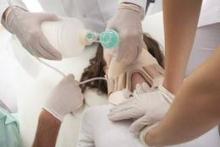PHOENIX – Pneumonia, dehydration, and septicemia topped the list of risk factors associated with the need for cardiopulmonary resuscitation during hospitalization for a major surgical procedure in 1 in 500 patients, a retrospective analysis found.
The large sample studied shows that having emergency rather than elective surgery, being older, being African American, and lacking health insurance were also associated with greater odds of needing CPR in this cohort, Dr. Ashima Das of Rainbow Children’s Hospital in Cleveland reported.
A review of 12,631,502 patient records found in the 2009 and 2010 National Inpatient Sample showed that 0.2% of all major surgery patients between 18 and 64 years went into cardiac arrest during their surgical hospitalization. Patients with postoperative pneumonia were at 3.05 (95% confidence interval = 2.75-3.39, P < .0001) times higher risk for needing CPR; meanwhile, major surgery patients with postoperative dehydration or other fluid and electrolyte disruptions faced an increased risk of 3.50 (95% CI = 3.18-3.85, P < .0001), Dr. Das reported at the Critical Care Congress, sponsored by the Society for Critical Care Medicine.
Septicemia posed a 2.60 greater risk (95% CI = 2.34-2.86, P < .0001). The odds ratio of needing CPR for patients with coagulopathy was 2.54 (95% CI = 2.30-2.81, P < .0001).
Dr. Das and her colleagues found that 80% of the 23,858 surgical procedures performed in patients who also needed CPR were emergent rather than elective. Patients’ risk of cardiac arrest increased by 1.02 ( 95% CI = 1.01-1.03, P < .0001) with every year of age, while African Americans had a slightly higher risk of needing CPR, compared with whites (OR, 1.51; 95% CI = 1.35-1.68; P < .0001), as did the uninsured, compared with the insured (P < .0001).
The authors of this study said they had no relevant financial disclosures.
On Twitter @whitneymcknight

